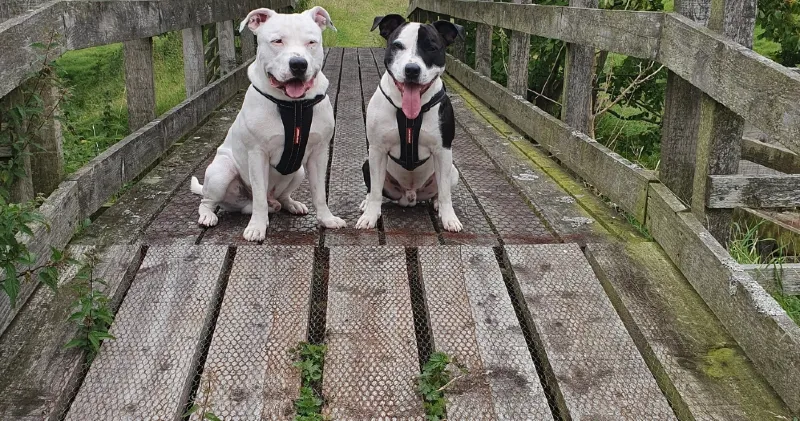Staffordshire Bull Terrier Traits: What They’re Really Like!

A complete, down-to-earth guide to Staffy temperament, personality, behaviour and quirks — from an owner with 2 from the same litter!
Staffies are one of the most misunderstood breeds in the UK. Ask a Staffy owner what they’re really like and you’ll hear the same things over and over:
- affectionate
- clownish
- clever (sometimes too clever)
- eager to please
- people-focused
- occasionally dramatic
- always full of heart
They’re brilliant family companions — but they’re not always easy.
If you’re thinking about getting a Staffy, or you already share your home with one, this guide covers the traits that matter most: temperament, behaviour tendencies, training style, social needs, exercise, and the small quirks that make them so loved.
1. Temperament: Affectionate, People-Focused, Emotional
A well-bred Staffy is a genuinely people-loving dog. They’re happiest when they’re close — often very close — to their humans. Staffy owners joke about their dogs being “velcro dogs,” but it’s not far from the truth.
What this means in real life:
- They bond deeply with their family.
- They thrive on human company.
- They can struggle with being left alone too long.
- They are sensitive to tone and emotion.
They’re also surprisingly gentle with people. The “nanny dog” nickname came from their calm, patient behaviour around children — though supervision is always required, as with any breed.
Staffies feel things fully. Joy, excitement, frustration, worry — they’re open books. This emotional honesty is part of their charm, but it’s also why consistent routines help them thrive.
2. Energy & Play Style: High Play Drive, Fast Excitability

Staffies have a reputation for being little powerhouses, and it’s accurate. They love play — tug, fetch, wrestling, chase, anything interactive.
Their energy style typically looks like:
- Short bursts of high intensity (the famous zoomies)
- Sudden excitement spikes triggered by toys, people, or new environments
- A natural enthusiasm for rough-and-tumble play
- A switch-off point where they suddenly flop and recharge
They’re not endurance dogs, but their bursts can surprise you.
A daily combination of physical exercise and structured downtime works best.
3. Behaviour Tendencies: Friendly, Social, Sometimes Over-Keen
Most Staffies are social butterflies — sometimes a little too social. They greet people like long-lost friends and can overwhelm visitors with enthusiasm.
Common behavioural traits:
- Very friendly with people
- Often confident with strangers
- Highly expressive body language
- Can jump up when excited
- Noise levels vary — some are quiet, others ‘talk’
Challenges to be aware of:
- Overexcitement during greetings
- Mouthiness in pups (they explore with their mouths)
- Pulling on the lead when excited
- Difficulty calming down after stimulation
All of these are manageable with early training, calm routines, and consistency.
4. Intelligence: Quick Learners, Emotionally Smart, Easily Overstimulated
Staffies are clever dogs — not the type that needs endless puzzle toys, but the type that reads people well and learns routines quickly.
They respond best to:
- positive reinforcement
- short, structured sessions
- calm, predictable cues
- clear boundaries
Where some breeds thrive on intense training schedules, Staffies benefit more from balance — bursts of learning followed by quiet time.
A tired Staffy is not always a calm Staffy.
A regulated Staffy is.
5. The “Clown” Gene: Goofy, Dramatic, Endlessly Entertaining
Staffy owners know: the breed has a built-in sense of humour.
Common quirks include:
- rolling upside-down for attention
- groaning theatrically during cuddles
- dramatic sighs
- throwing toys at you to start play
- sprint-and-flop routines
- the “Staffy smile”
These traits make them brilliant companions — especially for people who enjoy a lively, affectionate dog with personality.
6. Social Needs: Thrive on Contact, Struggle With Long Isolation
Staffies are incredibly people-oriented. This is one of their strongest traits, but it also means:
- long days alone aren’t ideal
- they benefit from bonding activities
- they love routines
- they like to feel included
This isn’t a breed that’s happy being independent for hours on end.
Most do best with:
- structured alone-time training
- calm exits and returns
- enrichment during alone time
- predictable daily routines
7. Physical Build: Muscular, Compact, Strong — With Breed-Specific Needs

A Staffy’s body shape affects a lot of their care:
Short, smooth coat
Means they feel the cold easily — especially in winter.
Depending on how adventurous you are, winter hiking may benefit from additional protection, such as paw balms, dog boots, or a dog coat for winter.
Broad chest, short back
Makes them one of the harder breeds to fit coat sizing for — accuracy matters.
Powerful build
Means:
- highly durable toys are favoured over plush toys
- good harness fit is essential
- secure leashes matter
8. Training Style: Eager to Please, Reward-Driven
Training Staffies is enjoyable because they genuinely want to work with you.
They respond well to:
- calm environments
- the balanced type of dog training
- short training repetitions
- consistent routines
- high-value rewards
- clear expectations
They do not respond well to:
- shouting
- harsh corrections
- chaotic environments
- inconsistent rules
If you train calmly, they follow calmly.
If you train excitedly, they become rockets.
9. Are Staffies Good Family Dogs? Yes — With Structure
A well-trained Staffy is:
- affectionate
- tolerant
- playful
- loyal
- people-focused
They excel in family homes because they like to be included and involved.
But — they also need:
- guidance
- consistent rules
- socialisation
- routines
- calm handling
They’re not a “set it and forget it” breed.
They’re a hands-on, highly rewarding breed for owners who enjoy being involved.
10. Staffy Myths vs Reality
“They’re aggressive.”
No — they’re one of the most human-friendly breeds when well-socialised.
“They’re hard to train.”
They’re actually very trainable; they just get overstimulated.
“They’re high-maintenance.”
Emotionally yes, physically no. Care needs are simple.
“They all hate dogs.”
Not true. Many are sociable, many are neutral, some are selective — like any breed.
Not all are reactive — many are sociable with the right introductions.
Final Thoughts: What Staffies Are Really Like
If you want a dog that:
- loves being close
- makes you laugh daily
- enjoys training
- thrives on your attention
- gives their whole heart to their family
…a Staffy is hard to beat.
They’re not always calm, not always easy, and they certainly have their “full-on” moments — but with structure, affection, and consistent routines, they’re one of the most rewarding companion dogs you can live with.
And once you’ve had one, it’s rare you stop at one.
